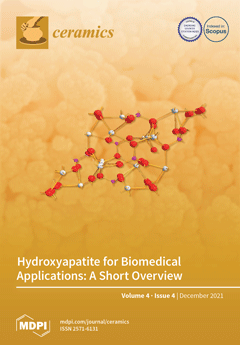Open AccessArticle
Synthesis and Characterization of Novel Calcium-Silicate Nanobioceramics with Magnesium: Effect of Heat Treatment on Biological, Physical and Chemical Properties
by
Konstantina Kazeli, Ioannis Tsamesidis, Anna Theocharidou, Lamprini Malletzidou, Jonathan Rhoades, Georgia K. Pouroutzidou, Eleni Likotrafiti, Konstantinos Chrissafis, Theodoros Lialiaris, Lambrini Papadopoulou, Eleana Kontonasaki and Evgenia Lymperaki
Cited by 8 | Viewed by 6364
Abstract
Glass-ceramic nanopowder with a composition of 55SiO
2-35CaO-10MgO (mol %) was synthesized by the sol–gel method and was heat treated at three temperatures (T1 = 835 °C, T2 = 1000 °C, T3 = 1100 °C) in order to obtain different materials (C1,
[...] Read more.
Glass-ceramic nanopowder with a composition of 55SiO
2-35CaO-10MgO (mol %) was synthesized by the sol–gel method and was heat treated at three temperatures (T1 = 835 °C, T2 = 1000 °C, T3 = 1100 °C) in order to obtain different materials (C1, C2, C3, respectively) varying in crystal structure. Bioactivity and oxidative stress were evaluated in simulated body fluid (SBF) for various time periods (up to 10 days). The structure of the synthesized materials and their apatite-forming ability were investigated by X-ray diffractometry (XRD), Fourier transform infrared spectroscopy (FTIR), Scanning Electron Microscopy and Energy Dispersive Spectroscopy (SEM/EDS). The antibacterial properties of the synthesized materials were evaluated against three Gram-positive and four Gram-negative bacterial strains and their biocompatibility was verified on a primary cell line of human gingival fibroblasts (HGFs) by the MTT (3-[4, 5-dimethylthiazol-2-yl]-2, 5 diphenyl tetrazolium bromide) assay. The crystallization of the materials was increased by sintering temperature. Heat treatment did not inhibit the bioactive behavior of the materials as apatite formation started after 3 days in SBF. C2, C3 showed some indications of apatite forming even from the first day. Regarding cell viability, a variety of biological behaviors, concerning both dose and time points, was observed between the positive control and the tested materials by both the MTT assay and oxidative stress analysis. In conclusion, the nanobioceramic materials of this study possess a multitude of attractive physicochemical and biological properties that make them suitable candidates for bone regeneration applications, fillers in nanocomposite scaffolds, or as grafts in bone cavities and periodontal lesions.
Full article
►▼
Show Figures





